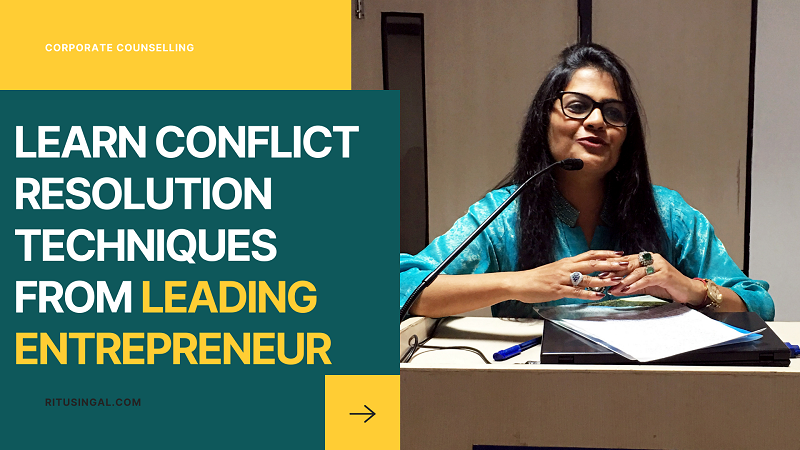
Learn Conflict Resolution Techniques from Leading Entrepreneur
There is not a single workplace that does not have its own set of problems. When it comes to the corporate sector, there are numerous problems, but none without a solution. Today, more and more people are joining the corporate culture, leading to more problems and chaotic situations.
Being a life coach and an entrepreneur, I have to carry both, health and work of employees together. But, many managers or bosses do not pay any attention to the employee’s well-being. Such work culture works like monarchy rule and not a democratic workplace. Conflicts in a workplace is like a termite. You won’t even know when it will start eating your organization. If conflicts are not resolved on time, they will eat-up your organization from the depths.
I have always given priority to the mental health of my employees. However, sometimes you cannot control everything, and things run out of your hands. I remember once we hired new talent in our organization. He had just completed his master’s and joined our business.
This guy was really efficient and skilled in his job. He would never make a mistake, you would never find anything wrong in his research or presentations. Everyone was impressed with his way of working. Things went well for the first few months.
However, soon he started making friends. His coworkers would appreciate his work and respect him. Being funny, productive, and efficient, everyone would think to themselves, ‘This person is really good at their job.’
Everyone started feeling this way for him. He would often teach other people skills and his working style. Everyone loved him and working with him. But soon, a new side of him started showing up. A side that no one appreciated or respected.
He soon started criticizing everything and everyone around him. He would talk something at your face and bitch about you behind your back. He started undermining people and interrupting in meetings. He would throw his ideas on others and expect everyone to follow what he feels was right. Things started getting harsh, and his coworkers started staying away from him. He even started taking credits and ownership of people’s ideas.
Things got even worse when he started saying, “I’m your boss.” Although he was not the boss, he would often refer to himself as one. It started bothering the people working in the same team. It was a team of five members, and all members were considered equal. But, he would often give commands pretending to be the ‘team lead’ which he clearly was not.
I started getting complaints about his behavior. So much so that sometimes the entire team except him would come and complain about their frustration. We were at a workplace lunch party once. So, I decided to check and meet this person to understand his behavior and working attitude.
I went towards their team and started appreciating their work. I said, “ Hey! You guys have improved your working style.”
Before anyone could say something, he replied, “ My team is the best mam, I make sure they give their best.”
I said, “ We all are a team and I hope you know you’re not their boss.”
He started laughing to cover his mistake and said he didn’t mean that. Although it was a party and could not say anything to him, I knew the complaints were right, and this person was very proud of himself. I called him, and why is he so bossy around his coworkers. He said he was the most educated and qualified out of his team members, and it automatically made him their superior.
I was stunned to see that attitude and mindset. However, I could not lose my calm and so I decided to handle the situation in a calm manner. I told him that I’d given him the team of most skilled people because he was good at his job too. But, as his team members have been complaining about him, I decided to change his team.
Now, since this guy thought teams and bosses are made based on qualification and seniority, I blended him into the team of most qualified and old employees of mine. He understood my lesson here and gave up his bossy attitude amongst his new team. He later apologized to his team and asked them to take him back in.
If you see the signs of an ego-driven person, you need to manage that as soon as you can. You will not want them to start pushing in your role and responsibilities. It is very important to set boundaries before they are broken.
What is conflict resolution at the workplace?
We all face many conflicts at some point in our lives. These can be personal or professional conflicts. While personal conflict can be solved in a hassle-free manner, workplace conflicts can get really ugly.
Workplace conflicts are very common and each one of us has faced them at some point in our lives. Most of the time, differences are created in an organization when individuals do not agree with each other.
Therefore, conflicts are an inevitable part of any organization. We cannot avoid conflicts, but we can learn to handle and prepare ourselves when a dispute arises. Conflict resolution at the workplace is the tricks and techniques of solving problems between two employees or managers.
Effective Conflict Resolution Techniques
No one wants to work on a battlefield. Everyone prefers a workplace that is harmonious and productive. You can create a safer place for your team and improve the lines of communication so that even if a conflict arises, you stay prepared and versed in conflict resolution.
Here are some amazing conflict resolution techniques you can use to handle conflicts at your workplace.
- Stop Being Right Always: When it comes to conflicts on a professional level, it is better to give up the winning or Mr. right attitude. Conflicts at the workplace can only be resolved with mutual understanding. You need to find new common ground. If you’ll view the other person or team as your opponent, it will doom both parties to remain adverse. Conflicts, if approached in a mutual atmosphere can bring better insights into your team.
- Don’t Play The Blame Game: One thing that often causes issues in any organization is putting blames. If you’re a manager or a team lead, and you see your team member doing something wrong or he/ she did something wrong, do not blame and shout at them. It will only result in sour employee relations and a toxic work environment. You need to focus on the process and give your team confidence that you’ve got their back. Blaming will create more conflicts among your employees.
- Create Space for Conversations: Conflicts often expand when they’re not discussed. Gossips and back-bitching often light the flame of anguish among both parties. When your organization creates a proper space for conversation, things become simpler. You can create clear channels for feedback to build a cohesive team. When you foster open communication, a lot of problems dampen even before spreading.
- Collaborate with Third-Party for conflict resolution: Most of the time, the office culture is biased. When you try to resolve a conflict between two parties, the side you choose will make you a biased judge no matter what you do. You should hire a third party for conflict resolution. No matter how big or small a conflict is, a third party will always make an honest and unbiased decision.
Why Choose Our Conflict Resolution Coaching?
Our conflict resolution coaching is designed especially to help people from various organizations to work towards a better work environment. Our conflict resolution process is done in six simple steps. We have helped many renowned organizations end their life-long conflicts and workplace problems with our counseling. Here is how our coaching works.
- Understand the cause of disagreement: No conflict can be resolved if you do not know where it all started. It is crucial to get to the heart of the conflict. When it comes to a personal conflict, it does not take much effort. However, when there’s a disagreement in office, we need to get both sides to agree on what the disagreement is. I first discuss the needs that are unmet on both sides to create a mutual understanding. Also, I obtain as much information as I can from both sides. I make sure both sides agree and understand the cause of the issue.
- Discover a common goal: The next step in our conflict resolution technique is establishing a common goal for both parties. For instance, if both parties are working towards the same goal, but are carrying a different perspective, they’ll be more truthful to reach the end goal. The aim for me here is to find what both the parties want and then find commonality on both sides.
- Discuss how the goal can be achieved: It is the third step and creates the most chaos. Now that you’ve brought both parties to agree on a common goal, the next step is to plan how to achieve those goals. When it comes to creating a plan and discussing ways, most people do not agree with each other. This step takes a lot of listening, communicating, and brainstorming together. I ensure I listen to both sides with an unbiased opinion. Once we run through all the options, we can easily choose the best ones.
- Working on the barriers to the goal: Now comes the part where understanding is done. When both parties can decide their goal and plan to achieve it, we try to dig in to find what caused the conflict before. In this step, I talk about what problems may prevent a resolution. When you understand the possible problems, you proactively find solutions and have plans to handle workplace issues. There will be two cases, things that can be changed and things that cannot be changed. The roadblocks are where things cannot be changed. We then work on these roadblocks.
- Find the best conflict resolution: This step is the gist of the entire coaching. It is the step where we decide on a common resolution plan. I ensure both parties are equally inclined and come up with the best conclusion. First, we discuss solutions and ways that both parties can agree with. Then, I find a common ground by asking both the parties. One thing that is very critical here is to end the conflict from the root. Because if you do not end it completely, it might come up again.
- Distribute Responsibilities: Now that we decide a resolution strategy in step five, it is time to distribute responsibilities that each party maintains in the solution. Once the team acknowledges and agrees upon resolution, we determine the responsibilities. As simple as it may sound, it is very crucial to bring both parties to agree to each other and take responsibility for their actions and solution.
In this way, our conflict resolution technique is unique and provides the best results. If your organization has been suffering due to constant conflicts among employees, contact us today to resolve and manage all your workplace problems.



